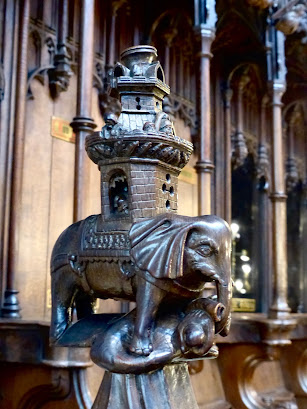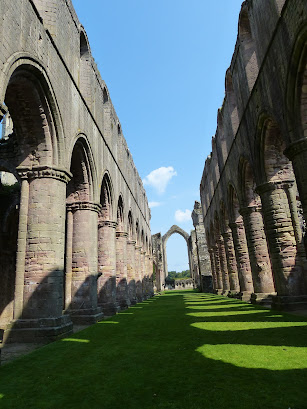The North of England feels older than the South.
It’s not, of course. Most of England can tell tales of the Stone Age, Romans, the Dark Ages or Roman Catholic glories. But the crowded, prosperous South has re-invented itself so many times ... and shifted so often to align with London trends ... that these ancient roots are harder to see. From Yorkshire on up, whether through lack of funds, a deeper appreciation of tradition or a pugnacious desire to go your own way, Northerners display a deeper, older history.
Roman Hadrian’s wall snakes through the countryside between Newcastle and Carlisle. Ruined abbeys and castles dot countryside and coast. The sinuous, writhing patterns of Anglo-Saxon, Celtic and Viking art are still prominent; Bamburgh Castle shows off a re-creation of the throne of the Northumbrian Kings. It's a thing of alien beauty closer to the Vikings or Tolkien than anything you’d immediately identify as “English”.
The most obvious place to see this difference is in the Northeast’s great cathedrals, where muscular Romanesque architecture, Celtic patterns and local saints held out longer and harder against outside trends, whether they were pushing up from London or Rome.
Durham Cathedral is the greatest example, and without doubt the grandest Romanesque building still standing in England. The enormous, muscular, patterned columns in its nave (above) and low, round arches on its lower levels speak to a distant, misty past more suited to King Arthur than Tudors or Georgians. The banner of the sainted King Oswald that hangs in the chapel where his head is interred looks more like the Norse god Odin than a traditional Catholic icon, complete with spooky ravens.
When I first saw this cathedral more than 30 years ago, I found it dark, mysterious and impossibly ancient. Since then, they’ve illuminated the upper stories of the building’s interiors to show off the architectural details. That has transformed the nave and called attention to the later gothic additions. It helps you appreciate more of the building, though it is a lot less atmospheric. I’ve also travelled Europe a lot more in those intervening years, so realise that though this Romanesque style is relatively unique to England, when compared to Italian churches it has a familiar feel.
Thus something different inspired me on this second, more mature visit. The virtuoso chapel of nine altars is a high Gothic addition that practically bolts a separate church onto the rear of the original, starting a level below and soaring above the back of the choir of the main church. The chapel of Oswald and the more famous Saint Cuthbert jut out into it, almost seeming to float in the massive, light-filled space. Though its pointed windows, tracery and vaulting have familiar parallels in the South, I’ve never seen a juxtaposition quite like this and the nine altars are dedicated to Northern saints, many of whom, like Oswald, aren’t recognised by the Roman church. So even in its grand, newer parts, Durham retains a mysterious sense of the other.

Ripon Cathedral is even more ancient than Durham, the current building’s foundations dating from the late 600s. Ancient Romanesque architecture features here, as well, and the original crypt is supposed to be magnificent, but it was still closed for pandemic safety due to its small, cramped proportions. This cathedral is most famous for its early gothic facade, comprised almost entirely of lancet windows and judged one of the best church exteriors in England by the architectural critic Nikolaus Pevsner. I’d recommend heading straight for the choir, however, where Ripon has managed to preserve one of the best collections of late medieval wood carving in the country, despite suffering the usual damage from reformers and civil wars through the years.
Carved during the time of Henry VII, the monks’ places were crowned by graceful, pinnacle-studded canopies. The ends of rows are marked by fanciful finials, one a monkey said to poke fun at a pompous church official, another a magnificent elephant with 11 apostles in a castle on its back while Judas is being strangled in its trunk.
The most precious carvings are hidden below, where ledges called misericords jut from the bottom of monks’ upturned benches to help them stand for long hours. Because of their little-seen nature, carvers were allowed to stretch their creativity on misericords, which often feature scenes of everyday life, jokes, or wild imaginings from myth and legend. One here features a rabbit and mouse being chased down a hole by a griffin, and is said to have inspired a young Lewis Carroll ... whose father was a clergyman here ... to later create the fantastic inhabitants of Wonderland.
Ripon is full of similar touches of quirky individuality. Jutting from the organ above the west side of the choir is a wooden hand, which the music director could use to direct singers even though he had to face away from them to play the organ. I’ve never seen another, and the guide insisted it’s unique in the country.
There’s a wonky arch where the architect got his measurements wrong. The Medieval stonecutters fixed it by inserting three bridging columns, then capped each with a laughing head to make fun of the mistake. A more poignant form of individuality stands above the high altar, where a Christ carved at the end of WWI is clean shaven, fresh-faced and short-haired, honouring the men who died in the trenches.
At the moment, Ripon’s greatest glory is its newest. A modern art installation called “On a wing and a prayer” invites worshippers to write prayers related to the current health crisis, and thanks for critical workers, on pieces of paper to be folded into bird shapes. Those have then been strung above the nave, a growing flock of white doves of peace hovering between us and heaven. It’s beautiful and tremendously moving.
Even if you stay away from the active cathedrals, religion looms large in the Northeast. Ruins of communities shut down in Henry VIII’s dissolution of the monasteries are strewn across the landscape. Many, like Byland, are just a few picturesque walls left standing in remote villages, deep down country lanes and accessible to any who want to stop.
Others are major tourist attractions, most famously Fountains Abbey. Not far from Ripon and Harrogate, what was a massive Cistercian foundation is now a monumental set of ruins set in emerald lawns at the bottom of a deep, wooded valley beside an idyllic river. In summer, it is a place of spectacular peace and beauty, though it must have been hard going in the winter. Especially for monks who were only allowed a brief stint in the warming house after hard labour outdoors. Otherwise, that marvellous but cold stone architecture must have made hard going.
Today you can appreciate not just the substantial ruins of the Abbey church but enough of the outbuildings to give you a proper sense of the sprawling complexes the monks built to create a self-sufficient community. One of the most complete structures at Fountains is the enormous, vaulted cellars, which are beautiful in their own right and tell a story about just how rich these establishments became. (And why they attracted the government’s greedy eye.)
In the 18th century, a local aristocrat made Fountains’ ruins the focal point of some exceptional water gardens. Visitors can explore those as well as the Abbey, wondering for miles along geometric pools of water, classical follies and woodland paths designed to open up at just the right point to offer artistically arranged views. This vast, outdoor area is perfect for sightseeing in the time of COVID-19, but even here numbers were limited and advance booking required. Most notable was the lack of diversity in accents. The families walking the paths or spread out on the lawns with picnics were overwhelmingly local. There were no bus tours, no large groups, and one assumes the handful of foreign accents I overheard were ... like mine ... current British residents who were born elsewhere. This lack of jostling, aggressive sightseers was one of the great joys of this holiday. And also made for some spectacular, people-free photos.
Though most of the Northern religious sites are either ruins or more tourist attraction than working religious space, we dropped by one notable difference. Ampleforth Abbey and College is one of the best-respected Catholic schools in England, and of particular interest to me as it is the “mother house” of the Saint Louis Priority, at which my mother taught and which my school considered our “brother” institution when we needed a co-educational experience. (Most notably, dates for school dances.)
English Benedictines maintained their traditions in exile for almost 300 years, returning to Yorkshire in 1802 to establish this beachhead for the renewed tradition. The majestic complex of buildings climbing a hill, with stretches of uninterrupted countryside as far as the eye can see, gives the visitor an idea of what the ruined abbeys might have been like had they survived.
Under normal circumstances, Ampleforth is bustling with more than 600 students, plus teachers and the monks in the Benedictine community. There’s a visitor centre, access to the Abbey Church, a cafe and a shop selling the cider, apple brandy, beer and honey made by the monks. Sadly, this was all closed due to the pandemic, so we had a little wander around the exteriors, struck up a conversation with a septuagenarian monk who’d been there since he was a lad at school and let him show us around his garden.
He, like so much of this part of the country, seemed imbued with something older and more mystic than life in the South. The profound sense of beauty and calm I found in the North’s religious sites would follow me throughout our trip.










No comments:
Post a Comment